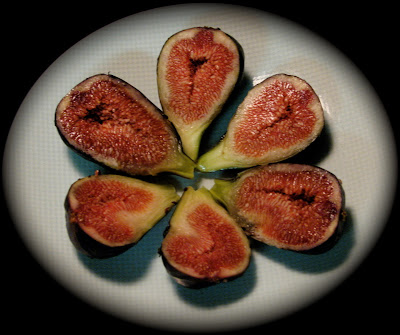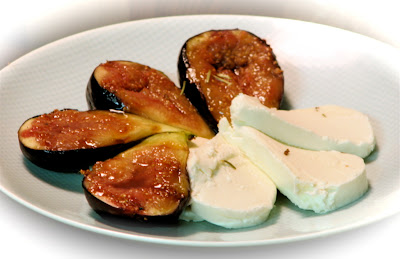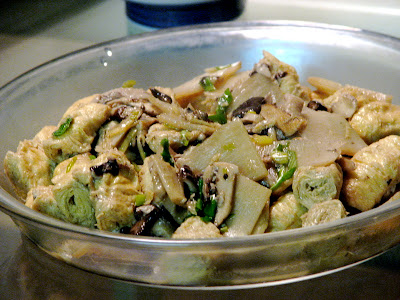Sunday, November 02, 2008
Sunday, September 21, 2008
Saturday, September 13, 2008
Steak Tartare
1. The Raw Truth: Don't Blame the Mongols (or Their Horses) by Craig S. Smith at NYT
2. Steak Tartare at The Food Timeline
3. The History of Steak Tartare By Richard L. Wottrich (various recipes of raw beef really)
2. Steak Tartare at The Food Timeline
3. The History of Steak Tartare By Richard L. Wottrich (various recipes of raw beef really)
Thursday, September 11, 2008
分一分五谷
农人说孔老夫子四体不勤五谷不分,不配做先生。我猜他老人家四体大概还是勤的,就冲那通游走列国,我们都知道那年头儿交通不便,至于五谷分不分就不知道了。我非夫子,却是真的五谷不分——连五谷是什么我都不知道。那日忽然有此发现,惊觉简直是白吃了数十年的饭。稍可安慰的是发现了总比没发现强。辨五谷不下大田或植物园还真不好办,好在泡网查查名字应不难,赶紧翻抄一通,整理如下。烦请纠错。
我们常说的五谷杂粮是稻谷、麦子、高梁、大豆、玉米。玉米源自南美洲,传入中国是十六世纪的事情了。而五谷一词出现于《论语》,那时的五谷与今日之五谷有何异同?
《周礼·天官》中有“以五味、五谷、五药养其病”,根据东汉郑玄的注释,此五谷为“麻、黍、稷、麦、豆”。分指大麻,黄米,小米,小麦大麦,和大豆。《周礼‧夏官‧职方氏》记载九州出产中,豫州和并州的五种谷物郑玄则注为“黍、稷、菽、麦、稻”。菽即豆,稻麻之别倒也未必矛盾,不同地域吧,总计六谷,若计较大麦小麦则七谷。更早明确五谷之谓的有春秋《范子计然》,我看到不同版本,更乱。一种曰:
战国《逸周书》中《职方》篇﹐即《周礼‧夏官‧职方氏》,也说“凡禾,麦居东方,黍居南方,稻居中央,粟居西方,菽居北方。” 与郑玄注释相合,但以粟代稷。
那粟是不是稷呢?根据《尔雅·释草》是的:稷,粟也。《本草纲目》又说:黏者为黍,不黏者为稷。这二者不矛盾,但也有认为稷就是不黏的黍。现今学者基本认同稷同粟,而黍、稷不同属。也有学者认为稷为S. italica var. germanica,粟为S. italica subsp. maxima,既改良稷 。不过汉末以降,都称小米为粟了。
另有清代程瑶田的《九谷考》以稷为高粱。梁早在《诗经》中就有出现,有后世学者认为既指稷,又有说粱后为高粱。但《三倉》云:“粱,好粟。” 比如一枕黄粱。高粱亦称蜀黍,《本草纲目》记载:“蜀黍北地种之,以备粮缺,余及牛马,盖栽培已有四千九百年”。看来此粱非彼粱。
稷、黍当是黄河流域华夏先民首先栽培。《诗经》多处黍稷并提,又有“黍稷是民食之主。” 主食外,黍还可酿酒。稷乃百谷之长,在古代之重要地位从后稷、社稷也可窥一斑。后稷乃周族始祖,教民耕种,播百谷。社为土神,稷为谷神,社稷便是国家。
最早的稻谷种植目前认为是中国,有百越先民所居的河姆渡出土的栽培稻谷为证,距今近七千年,虽然粳稻,籼稻分别被命名为日本型(O. sativa var. japonica),和印度型(O. sativa var. indica)。
麦既指大麦也指小麦,但诗经中也有将二者区分,比如《诗·周颂·思文》
菽的最早栽培则归功于东北山戎民族,后被数度引入中原。菽提供谷类所缺少的优质植物蛋白,更成就后来的豆腐酱油,是五谷中之非谷类。
另一非谷类是麻,原产中国,甘肃东乡林西出土有距今五千年前的大麻籽实物。大麻雄株为枲(xǐ)取用纤维、雌株为苴(jū)取食麻籽。麻籽至汉代都为食物。中国的大麻与印度大麻不同种。
简言之,五谷实是六七谷:黍、稷、菽、麦、稻、麻,在汉代马王堆一号墓辛追夫人的陪葬物中都有。五谷之前多称百谷,亦有九谷和六谷之说。百谷乃所有种植物谷类、豆类、蔬菜、水果之通称。九谷据今人考证是小米、黄米、稻谷、大麻、大豆、小豆、小麦、大麦和野米。
将前面所提开列于此,我到底还是不辨五谷:
稷 jì,粟 sù:小米 foxtail millet (Setaria italica)
黍 shǔ:黄米 broomcorn millet (Panicum miliaceum)
菽 shū:大豆 soybean (Glycine max)
麻 má:大麻 hemp (Cannabis sativa)
麦 mài:小麦 wheat (Triticum turgidum),大麦 barley (Hordeum vulgare)
稻 dào:大米 rice (Oryza sativa)
菰 gū:野米/茭白 wild rice (Zizania caduciflora)
小豆 dòu:azuki bean (Vigna angularis)
高粱 liáng:Chinese sorghum (Sorghum vulgare)
我们常说的五谷杂粮是稻谷、麦子、高梁、大豆、玉米。玉米源自南美洲,传入中国是十六世纪的事情了。而五谷一词出现于《论语》,那时的五谷与今日之五谷有何异同?
《周礼·天官》中有“以五味、五谷、五药养其病”,根据东汉郑玄的注释,此五谷为“麻、黍、稷、麦、豆”。分指大麻,黄米,小米,小麦大麦,和大豆。《周礼‧夏官‧职方氏》记载九州出产中,豫州和并州的五种谷物郑玄则注为“黍、稷、菽、麦、稻”。菽即豆,稻麻之别倒也未必矛盾,不同地域吧,总计六谷,若计较大麦小麦则七谷。更早明确五谷之谓的有春秋《范子计然》,我看到不同版本,更乱。一种曰:
五谷者,万民之命,国之重宝。。。东方多黍,南方多稷,西方多麻,(案《初学记》引作“东方多稻,西方多麦”)北方多菽,中央多禾,五土之所宜也,各有高下。高而阳者多豆,下而阴者多五谷。这一引弄出了七谷。且豆在五谷之外了,禾又是什么?再看《初学记》则有:
《范子·计然》曰:五谷者,万民之命,国之重宝。东方多麦稻,西方多麻,北方多菽,中央多禾。五土之宜,各有高下。高而阳者多豆,平而阴者多五谷。许慎《说文》曰:禾,嘉谷也。就是说禾还是小米。禾一般是谷类之统称,此处也可能合指黍、稷,就又是六谷。凑这个“五”字真是不少麻烦。
战国《逸周书》中《职方》篇﹐即《周礼‧夏官‧职方氏》,也说“凡禾,麦居东方,黍居南方,稻居中央,粟居西方,菽居北方。” 与郑玄注释相合,但以粟代稷。
那粟是不是稷呢?根据《尔雅·释草》是的:稷,粟也。《本草纲目》又说:黏者为黍,不黏者为稷。这二者不矛盾,但也有认为稷就是不黏的黍。现今学者基本认同稷同粟,而黍、稷不同属。也有学者认为稷为S. italica var. germanica,粟为S. italica subsp. maxima,既改良稷 。不过汉末以降,都称小米为粟了。
另有清代程瑶田的《九谷考》以稷为高粱。梁早在《诗经》中就有出现,有后世学者认为既指稷,又有说粱后为高粱。但《三倉》云:“粱,好粟。” 比如一枕黄粱。高粱亦称蜀黍,《本草纲目》记载:“蜀黍北地种之,以备粮缺,余及牛马,盖栽培已有四千九百年”。看来此粱非彼粱。
稷、黍当是黄河流域华夏先民首先栽培。《诗经》多处黍稷并提,又有“黍稷是民食之主。” 主食外,黍还可酿酒。稷乃百谷之长,在古代之重要地位从后稷、社稷也可窥一斑。后稷乃周族始祖,教民耕种,播百谷。社为土神,稷为谷神,社稷便是国家。
最早的稻谷种植目前认为是中国,有百越先民所居的河姆渡出土的栽培稻谷为证,距今近七千年,虽然粳稻,籼稻分别被命名为日本型(O. sativa var. japonica),和印度型(O. sativa var. indica)。
麦既指大麦也指小麦,但诗经中也有将二者区分,比如《诗·周颂·思文》
思文后稷,克配彼天。立我烝民,莫匪尔极。贻我来牟,帝命率育。无此疆尔界,陈常于时夏。来为小麦,牟为大麦,就是说那时农人已知道分别。大小麦栽培均源自中东,中国境内发现的最早小麦遗存在新疆孔雀河畔的古墓沟墓地中,距今约3800年。麦由古羌人带入中原,最终取代稷黍的地位。
菽的最早栽培则归功于东北山戎民族,后被数度引入中原。菽提供谷类所缺少的优质植物蛋白,更成就后来的豆腐酱油,是五谷中之非谷类。
另一非谷类是麻,原产中国,甘肃东乡林西出土有距今五千年前的大麻籽实物。大麻雄株为枲(xǐ)取用纤维、雌株为苴(jū)取食麻籽。麻籽至汉代都为食物。中国的大麻与印度大麻不同种。
简言之,五谷实是六七谷:黍、稷、菽、麦、稻、麻,在汉代马王堆一号墓辛追夫人的陪葬物中都有。五谷之前多称百谷,亦有九谷和六谷之说。百谷乃所有种植物谷类、豆类、蔬菜、水果之通称。九谷据今人考证是小米、黄米、稻谷、大麻、大豆、小豆、小麦、大麦和野米。
将前面所提开列于此,我到底还是不辨五谷:
稷 jì,粟 sù:小米 foxtail millet (Setaria italica)
黍 shǔ:黄米 broomcorn millet (Panicum miliaceum)
菽 shū:大豆 soybean (Glycine max)
麻 má:大麻 hemp (Cannabis sativa)
麦 mài:小麦 wheat (Triticum turgidum),大麦 barley (Hordeum vulgare)
稻 dào:大米 rice (Oryza sativa)
菰 gū:野米/茭白 wild rice (Zizania caduciflora)
小豆 dòu:azuki bean (Vigna angularis)
高粱 liáng:Chinese sorghum (Sorghum vulgare)
Wednesday, September 10, 2008
Tuesday, September 09, 2008
越南春卷 Vietnam Spring Roll
Filling: shrimp, rice vermicelli, cucumber, carrot, bamboo shoot, basil leaf, mint leaf, green onion
Dipping sauce: fish sauce 鱼露 2 Tbsp, water 4 Tbsp, sugar 1 tsp, vinegar 1.5 tsp, garlic 1 clove, hot pepper sauce
Sunday, September 07, 2008
Tuscan Yam Salad
INGREDIENTS (serves 4-6)
3-4 medium yams, peeled and cubed
3-4 roasted garlic (smashed)
1/3 cup caramelized onion
5-6 slices sun-dried tomatoes, chopped finely
10 leaves fresh basil, shredded
1 dash fresh ground black pepper
1 teaspoon balsamic vinegar
1/4 teaspoon of grated lemon rind
1/4 cup pine nuts, toasted
1/2 cup feta cheese, drained and crumbled
METHODS
1. Roast the yams in a little olive oil in a 375-400 oven until soft and a little brown on the outside, about 30 minutes (depending on how big the cubes are). Cool.
2. Mix remaining ingredients except for the pine nuts and cheese, and toss with the yams. Crumble in the cheese (if the cheese is too soft to crumble, use a fork to help it along; also crumbles better if frozen). Allow to sit in the fridge at least an hour to let the flavours develop (but will last several days in the fridge). Add pine nuts just before serving to keep them crunchy.
--from Recipezaar
3-4 medium yams, peeled and cubed
3-4 roasted garlic (smashed)
1/3 cup caramelized onion
5-6 slices sun-dried tomatoes, chopped finely
10 leaves fresh basil, shredded
1 dash fresh ground black pepper
1 teaspoon balsamic vinegar
1/4 teaspoon of grated lemon rind
1/4 cup pine nuts, toasted
1/2 cup feta cheese, drained and crumbled
METHODS
1. Roast the yams in a little olive oil in a 375-400 oven until soft and a little brown on the outside, about 30 minutes (depending on how big the cubes are). Cool.
2. Mix remaining ingredients except for the pine nuts and cheese, and toss with the yams. Crumble in the cheese (if the cheese is too soft to crumble, use a fork to help it along; also crumbles better if frozen). Allow to sit in the fridge at least an hour to let the flavours develop (but will last several days in the fridge). Add pine nuts just before serving to keep them crunchy.
--from Recipezaar
Saturday, September 06, 2008
Friday, September 05, 2008
Murri
from The Wilder Shores of Gastronomy
The most unexpected flavoring is murri. This was made by wrapping lumps of barley dough in fig leaves so that they would be attacked by mold, then mixing the moldy barley with flour, salt and water and allowing it to ferment for another month or more. The rotted barley paste would then be pressed to yield a dark-brown liquid which turns out to taste just like soy sauce. This whiff of soy ran through the food of the caliphs. The Arab sauce was not borrowed from China, however: Murri was never made from beans and it was always a liquid sauce, while the Chinese product was used as a paste until the 16th century.
--from Cooking with the Caliphs
on hongzhao 红糟
1.) The first reference to red ferment in the literature dates back to the late Han Dynasty (+177-217)-which means that I was incorrect by-oh, only 1,000 or so years! This is a controversial reference however, as it may not refer to the technology as we understand it today. However, by the Tang Dynasty, the poet Li Ho was already writing about "red wine":
In the crystal cup, the (sparkling) amber mash is thick,
And the wine drops from the little trough are pearly red.
2.) Here are two additional verses, both from Su Tung Po of the Sung Dynasty (+1036-1101):
In search of loacl products for an old friend,
I sent him post-haste "cured mash" and "red ferment"
and
Last year we shared a plate of tender alfalfa,
Tonight I pour a Min wine, red as cinnabar.
(Min = Fookienese)
3.) The red grain mould is Monascus sp. According to Dr. Huang, the (Fookienese) counties of Sung Chhi, Cheng Ho, Chien Ou, and Ku Thien (specially this last) are renowned for their red wine (and red mash).
4.) Today, this red wine is commonly called YELLOW wine (huang chieu).
--from http://chowhound.chow.com/topics/111597
A book review on
Science and Civilisation in China: Volume 6, Biology and Biological Technology, Part 5, Fermentations and Food Science
by H. T. Huang
The most unexpected flavoring is murri. This was made by wrapping lumps of barley dough in fig leaves so that they would be attacked by mold, then mixing the moldy barley with flour, salt and water and allowing it to ferment for another month or more. The rotted barley paste would then be pressed to yield a dark-brown liquid which turns out to taste just like soy sauce. This whiff of soy ran through the food of the caliphs. The Arab sauce was not borrowed from China, however: Murri was never made from beans and it was always a liquid sauce, while the Chinese product was used as a paste until the 16th century.
--from Cooking with the Caliphs
on hongzhao 红糟
1.) The first reference to red ferment in the literature dates back to the late Han Dynasty (+177-217)-which means that I was incorrect by-oh, only 1,000 or so years! This is a controversial reference however, as it may not refer to the technology as we understand it today. However, by the Tang Dynasty, the poet Li Ho was already writing about "red wine":
In the crystal cup, the (sparkling) amber mash is thick,
And the wine drops from the little trough are pearly red.
2.) Here are two additional verses, both from Su Tung Po of the Sung Dynasty (+1036-1101):
In search of loacl products for an old friend,
I sent him post-haste "cured mash" and "red ferment"
and
Last year we shared a plate of tender alfalfa,
Tonight I pour a Min wine, red as cinnabar.
(Min = Fookienese)
3.) The red grain mould is Monascus sp. According to Dr. Huang, the (Fookienese) counties of Sung Chhi, Cheng Ho, Chien Ou, and Ku Thien (specially this last) are renowned for their red wine (and red mash).
4.) Today, this red wine is commonly called YELLOW wine (huang chieu).
--from http://chowhound.chow.com/topics/111597
A book review on
Science and Civilisation in China: Volume 6, Biology and Biological Technology, Part 5, Fermentations and Food Science
by H. T. Huang
Tuesday, September 02, 2008
Sunday, August 31, 2008
Saturday, August 23, 2008
Wednesday, August 20, 2008
Tuesday, August 19, 2008
鱼鱼鱼
黄花鱼 yellow corvina, yellow croaker (difference?)
鲭鱼 鲐鱼 mackerel
鲅鱼 spanish mackerel
黑鱼 snakehead fish
鲳鱼 pomfret
鳕鱼 cod
黑鲈 sea bass
胭脂鱼 mullet
鲱鱼 青鱼 herring
凤尾鱼 anchovy
秋刀鱼 mackerel pike, saury
鲭鱼 鲐鱼 mackerel
鲅鱼 spanish mackerel
黑鱼 snakehead fish
鲳鱼 pomfret
鳕鱼 cod
黑鲈 sea bass
胭脂鱼 mullet
鲱鱼 青鱼 herring
凤尾鱼 anchovy
秋刀鱼 mackerel pike, saury
Yellow Corvina / Yellow Croaker
Yeonggwang is famous for its large production of croaker which Korean people choose one of the best presents for presents to other people. They are called these "rice thief" because of its wide popularity. Also, it is called Yeonggwang gulbi(meaning dried croaker) among Koreans. They originated from the Goryeo Dynasty. Yellow corvina moves northward from the East China Sea, where they spend the winter season, to Yeonpyeongdo Island, to spawn at the start of the thawing season. They spawn at sea in front of Chilsan, near Beopseongpo in Yeonggwang, between April 10 and 30, while moving northward.
-from wiki
Sunday, August 17, 2008
Glazed Grilled Salmon & Pan Fried Tomato
10-12 oz 三文鱼,1 Tbsp 红糖(或蜂蜜),1 Tbsp 酱油,Wasabi 适量根据口味,1 tsp 米醋 (original recipe)。
番茄厚片,撒dill weed,胡椒粉,几滴柠檬,沾蛋液,面粉/面包屑,煎 (original recipe)。
Friday, August 15, 2008
虾油,鱼露,Garum
Garum: http://penelope.uchicago.edu/~grout/encyclopaedia_romana/wine/garum.html
http://www.geocities.com/Athens/Ithaca/8337/c_garum.html
第五味觉: http://web.my8d.net/tmgma/new_page_11.htm
From "Medieval cuisine of the Islamic World"——
This ancient Roman-Berber recipe is attributed to Apicius, whose life straddled the first century B.C.E. and the first century C.E. "Chicken in the Numidian fashion" -- ... -- is not so very different from the barida of chicken created by Iraqi gastronomes in the early ninth century, many recipes from which are associated with the Abbasid caliphs. The ingredients are practically the same: ... The difference is that the Islamic dish has murri, another salty fermented condiment, in place of garum. -pp22
The medieval kitchen used condiments whose flavor is yet distantly imaginable to us, such as murri (similar to soy sauce), kamakh (a sort of cheese spread), and bunn (analogous to the thick paste from which soy sauce is pressed.) These condiments were essential in cooking, above all in Baghdad during the tenth century, but also in Andalusia and Egypt, where we know of their use only from the thirteenth century. ... murri or kamakh, which are based on the long and involved fermentatin of cereals or salted fish.
These condiments seem to have been comparable to East Asian sauces such as Chinese soy sauce and Vietnamese nuoc mam, themselves recreations, using modern food technologies, of ancient artisanal products. Preservation by salting or brining was widespread throughout the medieval world. The sauces mentioned by Apicius, garum and liquamen, were for centuries considered indispensable in Greco-Roman cooking. Garum was obtained by marinating fish intestines; murri (in one of it several versions) by marinating small dried fish (sir) in salt, aromatic herbs, must, and wine; and modern nuoc mam by marinating salted fresh anchovies. -pp 54
http://www.geocities.com/Athens/Ithaca/8337/c_garum.html
第五味觉: http://web.my8d.net/tmgma/new_page_11.htm
From "Medieval cuisine of the Islamic World"——
This ancient Roman-Berber recipe is attributed to Apicius, whose life straddled the first century B.C.E. and the first century C.E. "Chicken in the Numidian fashion" -- ... -- is not so very different from the barida of chicken created by Iraqi gastronomes in the early ninth century, many recipes from which are associated with the Abbasid caliphs. The ingredients are practically the same: ... The difference is that the Islamic dish has murri, another salty fermented condiment, in place of garum. -pp22
The medieval kitchen used condiments whose flavor is yet distantly imaginable to us, such as murri (similar to soy sauce), kamakh (a sort of cheese spread), and bunn (analogous to the thick paste from which soy sauce is pressed.) These condiments were essential in cooking, above all in Baghdad during the tenth century, but also in Andalusia and Egypt, where we know of their use only from the thirteenth century. ... murri or kamakh, which are based on the long and involved fermentatin of cereals or salted fish.
These condiments seem to have been comparable to East Asian sauces such as Chinese soy sauce and Vietnamese nuoc mam, themselves recreations, using modern food technologies, of ancient artisanal products. Preservation by salting or brining was widespread throughout the medieval world. The sauces mentioned by Apicius, garum and liquamen, were for centuries considered indispensable in Greco-Roman cooking. Garum was obtained by marinating fish intestines; murri (in one of it several versions) by marinating small dried fish (sir) in salt, aromatic herbs, must, and wine; and modern nuoc mam by marinating salted fresh anchovies. -pp 54
Sunday, August 10, 2008
Broiled Mackerel with Ginger and Garlic
INGREDIENTS
4 (8-oz) mackerel fillets
2 tablespoons minced peeled fresh ginger
2 tablespoons minced garlic
2 tablespoons fresh lime juice
1 tablespoon vegetable oil
1 1/2 teaspoons salt
1 1/2 teaspoons chili powder
1 teaspoon turmeric
1 cup loosely packed fresh cilantro sprigs
Accompaniment: lime wedges
METHODS
Put fillets, skin sides down, in a lightly oiled large shallow baking pan.
Stir together ginger, garlic, lime juice, oil, salt, chili powder, and turmeric in a small bowl until combined well, then rub onto mackerel flesh and marinate 10 minutes.
Preheat broiler. Broil mackerel 5 to 6 inches from heat, without turning, until cooked through and lightly browned, 7 to 8 minutes. Transfer to plates with 2 spatulas and top with cilantro.
--From epicurious
Thursday, August 07, 2008
Wednesday, August 06, 2008
Saturday, August 02, 2008
Monday, July 28, 2008
蚕豆瓣沙拉&豌豆全麦汤
Broad bean salad: lemon zest, lemon juice, olive oil, salt, pepper, fresh mint, shaved hard cheese
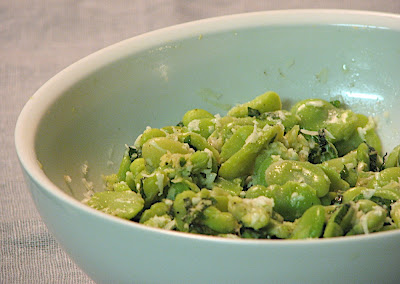
Split pea and whole wheat (in place of barley), a few pieces mushroom to enhance flavor (no stock is used). Lemon juice and basil (puree would be the best) when serving.

Split pea and whole wheat (in place of barley), a few pieces mushroom to enhance flavor (no stock is used). Lemon juice and basil (puree would be the best) when serving.
Friday, July 25, 2008
油桃带子沙拉
昨天看到这个salad菜谱,名字里的几样东西一看就吸引人。菜谱看上去很长,太繁复的东西我一般只看看,过过眼瘾算了。不过也要细辨,如今有些菜谱为了出新出奇,有故弄玄虚之嫌,比如此菜谱中两个法文的调料,其实不过是特种盐,特种辣椒粉,一般人家断不会有的,以普通盐辣椒粉替代就完了。若把玄虚去掉,由繁改简,仍足够好吃好看,就不妨一试。材料家里刚好都有,再去揪一把basil。此沙拉各种材料确是佳配,犹适夏天。我没有青柠以柠檬替代,另加少许balsamic vinegar。Basil puree也嫌麻烦,热水抄后切碎拌上油了事,也许puree效果会更好。
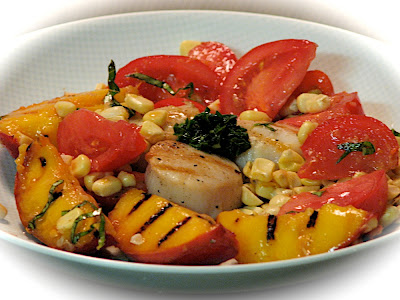
Grilled Scallops And Nectarines Salad
INGREDIENTS
Dressing:
3 tablespoons fresh lime juice
1 1/2 teaspoons finely grated lime peel
1/8 teaspoon (generous) piment d'Espelette or chili powder
3 tablespoons extra-virgin olive oil
Fleur de sel (a type of sea salt)
Basil Puree:
3/4 cup (loosely packed) fresh basil leaves
1/4 cup extra-virgin olive oil
Fleur de sel
Salad:
24 large sea scallops, side muscles removed, patted dry
3 firm but ripe nectarines (white or yellow), each cut into 6 wedges
Olive oil, for brushing
1 1/2 cups fresh corn kernels, cut from 2 large ears of corn
24 grape or cherry tomatoes, halved
1/3 cup thinly sliced basil leaves
Fleur de sel
PREPARATION
For dressing:
Whisk lime juice, lime peel, and piment d'Espelette in small bowl. Gradually whisk in oil. Season with fleur de sel and pepper. DO AHEAD: Can be made 1 day ahead. Chill. Bring to room temperature before using.
For basil puree:
Blanch basil in small pot of boiling salted water 30 seconds; drain. Squeeze to remove as much water as possible, then coarsely chop. Puree basil and oil in blender until smooth. Transfer to small bowl. Season to taste with fleur de sel. DO AHEAD: Can be made 1 day ahead. Cover and chill. Return to room temperature before using.
For salad:
Prepare barbecue (medium-high heat). Brush scallops and nectarines with oil; sprinkle with salt and pepper. Grill scallops until slightly charred and cooked through, about 2 minutes per side. Grill nectarines until slightly charred, about 1 1/2 minutes per side. Transfer scallops and nectarines to plate. Arrange 4 scallops on each of 6 plates. Toss corn and 2 tablespoons dressing in medium bowl. Toss tomatoes with 1 tablespoon dressing in another bowl; season to taste with salt and pepper. Spoon corn around scallops. Scatter tomatoes over corn. Arrange nectarine wedges decoratively on plates. Drizzle some dressing over scallops, then spoon some basil puree over. Sprinkle sliced basil and fleur de sel over corn and tomatoes and serve.
Ingredients: Piment d'Espelette is the ground powder of a small, dried, hot red chile grown in Espelette, France. It is available at specialty foods stores and from zingermans.com.
-From epicurious
Dressing:
3 tablespoons fresh lime juice
1 1/2 teaspoons finely grated lime peel
1/8 teaspoon (generous) piment d'Espelette or chili powder
3 tablespoons extra-virgin olive oil
Fleur de sel (a type of sea salt)
Basil Puree:
3/4 cup (loosely packed) fresh basil leaves
1/4 cup extra-virgin olive oil
Fleur de sel
Salad:
24 large sea scallops, side muscles removed, patted dry
3 firm but ripe nectarines (white or yellow), each cut into 6 wedges
Olive oil, for brushing
1 1/2 cups fresh corn kernels, cut from 2 large ears of corn
24 grape or cherry tomatoes, halved
1/3 cup thinly sliced basil leaves
Fleur de sel
PREPARATION
For dressing:
Whisk lime juice, lime peel, and piment d'Espelette in small bowl. Gradually whisk in oil. Season with fleur de sel and pepper. DO AHEAD: Can be made 1 day ahead. Chill. Bring to room temperature before using.
For basil puree:
Blanch basil in small pot of boiling salted water 30 seconds; drain. Squeeze to remove as much water as possible, then coarsely chop. Puree basil and oil in blender until smooth. Transfer to small bowl. Season to taste with fleur de sel. DO AHEAD: Can be made 1 day ahead. Cover and chill. Return to room temperature before using.
For salad:
Prepare barbecue (medium-high heat). Brush scallops and nectarines with oil; sprinkle with salt and pepper. Grill scallops until slightly charred and cooked through, about 2 minutes per side. Grill nectarines until slightly charred, about 1 1/2 minutes per side. Transfer scallops and nectarines to plate. Arrange 4 scallops on each of 6 plates. Toss corn and 2 tablespoons dressing in medium bowl. Toss tomatoes with 1 tablespoon dressing in another bowl; season to taste with salt and pepper. Spoon corn around scallops. Scatter tomatoes over corn. Arrange nectarine wedges decoratively on plates. Drizzle some dressing over scallops, then spoon some basil puree over. Sprinkle sliced basil and fleur de sel over corn and tomatoes and serve.
Ingredients: Piment d'Espelette is the ground powder of a small, dried, hot red chile grown in Espelette, France. It is available at specialty foods stores and from zingermans.com.
-From epicurious
Thursday, July 24, 2008
玫瑰荔枝冰砂 Rose Lychee Sorbet
荔枝 Lychee:20粒 pieces,冷冻一宿 Freeze overnight
干玫瑰花 Dried rose buds:12
薄荷叶 Fresh mint leaves:4-5
放搅拌机中打碎 Blend all in the blender. Serve.
Wednesday, July 23, 2008
榴莲
每次在中国超市看到整个的冰冻榴莲我都在前流连一会儿,但从没买过,不会挑也不知怎样打开又怕把家里弄的臭气熏天。昨天在冰柜一排看到榴莲果实,赶紧就抓了两盒。回到家兴高采烈地说,你猜我今儿买了什么?那边想都不想就答,榴莲。
我第一次吃榴莲是几年前朋友家爬梯,送一帮来此短期培训的朋友回国。一广东人带来了一整颗榴莲,说给大家尝尝。这东西臭名远扬,我也在超市看见过它布满尖刺的外表,但内里的果实我见都没见过。酒足饭饱到了榴莲时刻,大家围着大桌子等。多数人没吃过,都很好奇。等到一打开,打伙掩鼻的掩鼻离坐的离坐,只有坐我旁边的姐们儿,说在国内吃过,很喜欢,颇为期待的表情。当然朋友带来给我们尝新,又全套服务地剥好,一块一块递过来,我们也不好太过分,所以初始的片刻混乱之后大家又坐好,尽量憋着气。好在有鲍鱼之肆一说,倒也不必憋气太久。拿过来往鼻前一送,有人就拒吃了,咬了一口的有吐出来的,也有勉强下咽,绝不再碰第二下的。
我小心翼翼屏气将一片嫩黄果肉送到嘴里,一开始感觉不好,但稍坚持一下,发现爽滑甜腻,其味也香,口感略似黄油但绝无脂气,因是刚刚解冻的,又如冰激凌,总之好吃的很。又大胆地深吸一口气,原来一股醇香啊,虽然颇霸道。一块不够,我又讨了一块。这香臭之间原不过一线之隔,由远及近,转换就在那一瞬间,且那气味过鼻不忘。
第一次去香港,我们住在湾仔,晚上往铜锣湾那边溜达。经过一家超市门口,我就闻到一股熟悉的臭香,立即拉着A寻“香”而进。我说我给你介绍一样好吃的。买了一盘剥好的榴莲用塑料膜紧紧的包着。回到旅店,A在大堂问些事情,我等不及了,就回到屋里先取了一块榴莲吃,甘香浓郁,远非冰冻的可比。等A一进屋,大叫,这什么味道,大有要晕倒之势。我赶紧递给他一片,他一尝之下,竟也是喜欢。过两天去那家店又买了一盘。我以为榴莲在香港哪都有卖,但好像不是,也许是季节不对。
等到再去香港,我就惦记上榴莲了。又到铜锣湾找到那家超市,看到一大堆榴莲堆在地上,也有剥好的。我们挑剥好的,旁边一人边看边指点我们什么样的甜,听口音是个英国人,一问是在新加坡住过的。他却不买剥好的,让售货员给他拿整颗的,售货员拿来撬开一点给他过目,挑了几个直到他满意。称好后又给都剥出来。我们一看这个更过瘾,就请售货员也帮我们挑一个。售货员很认真的一个一个地敲敲打打,有的撬开看看又扔回去,终于找到一个她自己满意了的,给我们都收拾好。到附近的维多利亚公园,在人少的地方找条板凳坐下,取出榴莲来,果然分外香甜醇厚。先有点怕那个味道影响周围的人,发现无人侧目,我们也就放心大胆了。一会儿就报销了整个榴莲。又转回去那家超市,那个售货员见我们回来,一笑,就又给我们挑起榴莲来。
这东西上瘾,可惜难得吃到。冰冻的也好,聊胜于无。
我第一次吃榴莲是几年前朋友家爬梯,送一帮来此短期培训的朋友回国。一广东人带来了一整颗榴莲,说给大家尝尝。这东西臭名远扬,我也在超市看见过它布满尖刺的外表,但内里的果实我见都没见过。酒足饭饱到了榴莲时刻,大家围着大桌子等。多数人没吃过,都很好奇。等到一打开,打伙掩鼻的掩鼻离坐的离坐,只有坐我旁边的姐们儿,说在国内吃过,很喜欢,颇为期待的表情。当然朋友带来给我们尝新,又全套服务地剥好,一块一块递过来,我们也不好太过分,所以初始的片刻混乱之后大家又坐好,尽量憋着气。好在有鲍鱼之肆一说,倒也不必憋气太久。拿过来往鼻前一送,有人就拒吃了,咬了一口的有吐出来的,也有勉强下咽,绝不再碰第二下的。
我小心翼翼屏气将一片嫩黄果肉送到嘴里,一开始感觉不好,但稍坚持一下,发现爽滑甜腻,其味也香,口感略似黄油但绝无脂气,因是刚刚解冻的,又如冰激凌,总之好吃的很。又大胆地深吸一口气,原来一股醇香啊,虽然颇霸道。一块不够,我又讨了一块。这香臭之间原不过一线之隔,由远及近,转换就在那一瞬间,且那气味过鼻不忘。
第一次去香港,我们住在湾仔,晚上往铜锣湾那边溜达。经过一家超市门口,我就闻到一股熟悉的臭香,立即拉着A寻“香”而进。我说我给你介绍一样好吃的。买了一盘剥好的榴莲用塑料膜紧紧的包着。回到旅店,A在大堂问些事情,我等不及了,就回到屋里先取了一块榴莲吃,甘香浓郁,远非冰冻的可比。等A一进屋,大叫,这什么味道,大有要晕倒之势。我赶紧递给他一片,他一尝之下,竟也是喜欢。过两天去那家店又买了一盘。我以为榴莲在香港哪都有卖,但好像不是,也许是季节不对。
等到再去香港,我就惦记上榴莲了。又到铜锣湾找到那家超市,看到一大堆榴莲堆在地上,也有剥好的。我们挑剥好的,旁边一人边看边指点我们什么样的甜,听口音是个英国人,一问是在新加坡住过的。他却不买剥好的,让售货员给他拿整颗的,售货员拿来撬开一点给他过目,挑了几个直到他满意。称好后又给都剥出来。我们一看这个更过瘾,就请售货员也帮我们挑一个。售货员很认真的一个一个地敲敲打打,有的撬开看看又扔回去,终于找到一个她自己满意了的,给我们都收拾好。到附近的维多利亚公园,在人少的地方找条板凳坐下,取出榴莲来,果然分外香甜醇厚。先有点怕那个味道影响周围的人,发现无人侧目,我们也就放心大胆了。一会儿就报销了整个榴莲。又转回去那家超市,那个售货员见我们回来,一笑,就又给我们挑起榴莲来。
这东西上瘾,可惜难得吃到。冰冻的也好,聊胜于无。
Sunday, July 20, 2008
Wednesday, July 16, 2008
Sunday, July 13, 2008
自制酸奶
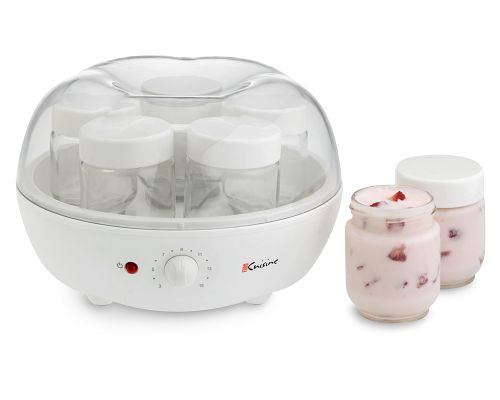 洋办法(我们已淘汰了):
洋办法(我们已淘汰了):买一个yogurt maker,我用过这一种,William-Sonoma有卖。照说明书来就行了。
 Yogurt starter:可以用店里买的酸奶,或省事用dry starter,比如这种,我用过,Wholefood有卖。
Yogurt starter:可以用店里买的酸奶,或省事用dry starter,比如这种,我用过,Wholefood有卖。土办法(我们现在用的):
材料: 1 gallon whole milk, 1-1.5 cups (8-12oz)plain yogurt with live culture
用具: 大锅一只,大浴巾一块,塑料布一张,被子或毯子一床
步骤:
1. 中小火加热牛奶至表面开始起泡,但不要开;同时把做引子的酸奶拿出冰箱;
2. 冷却至110-115F,土法测量:放入手指能坚持数到二十(~二十秒,不要太舒服哈);
3. 酸奶引子放一碗中,加入少量冷却的牛奶,拌匀,倒入锅中搅拌;
4. 盖上锅盖,用浴巾从下到上包严,再用塑料布包严,上用被子或毯子盖严;
5. 室温下(家里比较暖和的地方)8-10小时(一夜);
6. 打开包裹,擦去锅盖上积水,再盖上,放冰箱24小时。
注意:
牛奶可以用低脂,当然全脂更好吃,不要用很长保质期的(一个月)那种,内有添加物。也可加奶粉使更稠,我不用。
酸奶引子一定要plain的,有活菌,否则做不出,也可用自己制的酸奶留一点下次用,但最好不连续用。也可用dry starter,用量照说明。
冷却后的牛奶可倒入其他容器,保温(在110F左右)方法亦有多种。
容器,碗一定要干净,若用手指测温度,手要洗干净,细菌在酸奶发酵过程中也会multiply的。
揭开容器盖时,尽量不要让积水回流,那样酸奶易坏。
若想要很稠的酸奶有两种办法:
1. 吊。将酸奶置纱布中,滴水几小时,结果稠度可如奶酪。但我不用,主要是麻烦,另滴出的水叫whey,很有营养,扔掉可惜;
2. 容器中酸奶只要取出一点,就会开始出水(出whey),放的越久出水越多,剩下的就越稠,若是将水倒出效果更好。
我自己最爱的是最后几乎稠如奶酪的酸奶,加蜂蜜。我不喜whey,结果我大概并没有得到酸奶中的营养,只在吃其中的fat了。酸奶稀释或者用whey可以做yogurt drink,如波斯餐馆中的,很适合夏天。
Yogurt drink:
1 cup yogurt, 1-1.5 cups water
1/2 tsp salt
optional: 1/4 tsp of dry mint, savory, dry rose pedal (crushed or powered)
serve cold
Saturday, July 12, 2008
今天吃什么
天气真热。早晨起来看DG趴在包着酸奶的那个大被子上,可爱死了。阿林拿个大浴巾包着他出门,脑袋从前边露出来,尾巴从后面露出来,可怜兮兮的。他已经拒绝吃东西了,我们不得不硬喂了他些三文鱼,就把他留在院子里——他最喜欢的地方,也不过就是在一片阴凉下绻着,不知还能绻多久。
天热的人也没有食欲,数了数从早到晚吃的东西,却也不少。早晨是面包放上奶酪在炉子里烤烤,我做面包的热情日减,可架不住阿林总叨念。然后去摘了几个小西红柿,红的黄的,还有草莓。中午我们说喝果汁吧——最近喝的热火朝天,每晚做好了饭跟那晾着不吃先切水果——于是一人两杯,西瓜菠萝芒果草莓哈密瓜一通搅和。再加上我昨晚烤的香蕉核桃糕。下午又吃了一大碗酸奶,自己做的,很酸很稠,我总要厚厚地浇一层蜂蜜。这么一数,发现我们自力更生的程度不算低了,菜种的还少,也有开始的趋势,不知会不会有一天要种庄稼了。


晚饭倒是正经吃了的,清炒土豆丝和香菇芦笋,也算清淡。最近总爱炒土豆丝,不知有什么东西我身体里缺——不至于是淀粉吧——没两天就又忍不住乖乖地咚咚咚切丝去了。羡慕人家有刀功的能切得又快又匀又细又长,我总不能,又无耐心练。记得我老爸是有这功夫的,我也是偶然发现。他做饭的年头不长,那时我很少去厨房,何况那么小的厨房也转不开,后来也不怎么在家住了。
爸那时有个很会做菜的朋友,来北京出差,来家里就会授他几招。家里相熟的客人来就要点爸的菜,其实都不是什么上台盘的东西,主要的trick好像就是油多,可确实好吃,也好看。后来家里请了人,就谁都不做饭了。有一次老爸说,这个菜不太对,我来试试。等装了盘端上桌一看,他自己都觉着不对劲,立马又拿去回锅——这事儿我和我妈总记着。
另一样令我上瘾的是苦瓜,可是只有中国店卖,又不禁放,很麻烦,以后种菜当属首选。阿林说不知这土豆和苦瓜有啥共同元素,让你上瘾,嘿嘿,估计他是吃烦了。

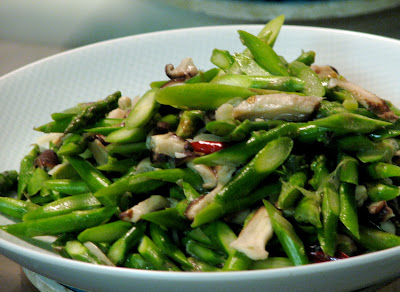
天热的人也没有食欲,数了数从早到晚吃的东西,却也不少。早晨是面包放上奶酪在炉子里烤烤,我做面包的热情日减,可架不住阿林总叨念。然后去摘了几个小西红柿,红的黄的,还有草莓。中午我们说喝果汁吧——最近喝的热火朝天,每晚做好了饭跟那晾着不吃先切水果——于是一人两杯,西瓜菠萝芒果草莓哈密瓜一通搅和。再加上我昨晚烤的香蕉核桃糕。下午又吃了一大碗酸奶,自己做的,很酸很稠,我总要厚厚地浇一层蜂蜜。这么一数,发现我们自力更生的程度不算低了,菜种的还少,也有开始的趋势,不知会不会有一天要种庄稼了。


晚饭倒是正经吃了的,清炒土豆丝和香菇芦笋,也算清淡。最近总爱炒土豆丝,不知有什么东西我身体里缺——不至于是淀粉吧——没两天就又忍不住乖乖地咚咚咚切丝去了。羡慕人家有刀功的能切得又快又匀又细又长,我总不能,又无耐心练。记得我老爸是有这功夫的,我也是偶然发现。他做饭的年头不长,那时我很少去厨房,何况那么小的厨房也转不开,后来也不怎么在家住了。
爸那时有个很会做菜的朋友,来北京出差,来家里就会授他几招。家里相熟的客人来就要点爸的菜,其实都不是什么上台盘的东西,主要的trick好像就是油多,可确实好吃,也好看。后来家里请了人,就谁都不做饭了。有一次老爸说,这个菜不太对,我来试试。等装了盘端上桌一看,他自己都觉着不对劲,立马又拿去回锅——这事儿我和我妈总记着。
另一样令我上瘾的是苦瓜,可是只有中国店卖,又不禁放,很麻烦,以后种菜当属首选。阿林说不知这土豆和苦瓜有啥共同元素,让你上瘾,嘿嘿,估计他是吃烦了。


Banana Walnut Bread
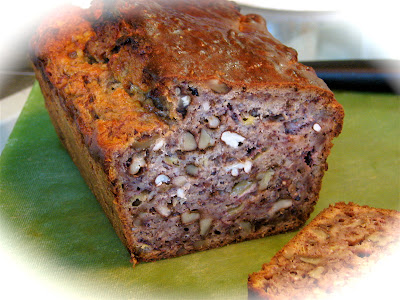
Most banana (walnut) bread recipes are too heavy and too sweet. I modified this simple banana bread recipe to make it less overwhelming but still rich. With less sugar, the fragrance and sweetness of bananas stand out. The riper the bananas, the sweeter the result.
INGREDIENTS
4 ripe bananas, smashed
1 cup walnut & pecan, chopped
1/6 cup melted butter (1/3 of a stick)
1/4 cup sugar
2 eggs, beaten
1 teaspoon vanilla
1 teaspoon baking soda
Pinch of salt
1 cup all-purpose, 1/2 cup whole-wheat flour
METHOD
No need for a mixer for this recipe. Preheat the oven to 350°F (175°C). With a wooden spoon, mix butter into the mashed bananas in a large mixing bowl. Mix in the sugar, egg, and vanilla. Sprinkle the baking soda and salt over the mixture and mix in. Add the flour last, mix. Pour mixture into a buttered 4x8 inch loaf pan. Bake for 1 hour. Cool on a rack. Remove from pan and slice to serve.
Saturday, May 24, 2008
Ceviche - denaturation
Traditional Peruvian cold appetizer known as ceviche is prepared by chemically "cooking" raw fish and shellfish in an acidic citrus marinade, without heat. It's an example of protein denaturation.
Protein folds on itself so that hydrophobic elements of the protein are buried deep inside the structure and hydrophilic elements end up on the outside. The final shape of a protein determines how it interacts with its environment.
When a protein is denatured, the secondary and tertiary structures are altered but the peptide bonds between the amino acids are left intact. Since the structure of the protein determines its function, the protein can no longer perform its function once it has been denatured.
----
The name - One theory suggests that the Ceviche got its name from the Quechua word "siwichi". However, it is more likely for the name to be a cognate of the Spanish word "escabeche" (marinade), derived from the Arabic term "sikbaj". Another theory suggests that its name comes from the word Cebo, the name given to the Corvina (sea bass) fish by black Peruvians.
Protein folds on itself so that hydrophobic elements of the protein are buried deep inside the structure and hydrophilic elements end up on the outside. The final shape of a protein determines how it interacts with its environment.
When a protein is denatured, the secondary and tertiary structures are altered but the peptide bonds between the amino acids are left intact. Since the structure of the protein determines its function, the protein can no longer perform its function once it has been denatured.
----
The name - One theory suggests that the Ceviche got its name from the Quechua word "siwichi". However, it is more likely for the name to be a cognate of the Spanish word "escabeche" (marinade), derived from the Arabic term "sikbaj". Another theory suggests that its name comes from the word Cebo, the name given to the Corvina (sea bass) fish by black Peruvians.
Wednesday, April 16, 2008
Tuesday, April 15, 2008
Thursday, March 20, 2008
Keep that good stuff coming
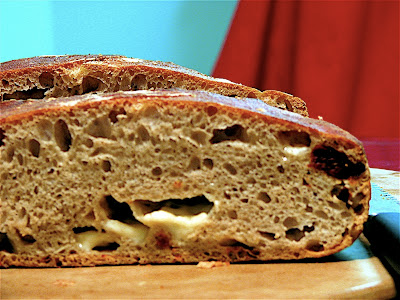
My fifth bread is delicious with the beautiful combination of Piave cheese, garlic and sun-dried tomato.
Monday, March 17, 2008
Kick it up a notch
My fourth bread with olives and thyme
Saturday, March 15, 2008
Third time is the charm
My third bread: perfect!
Thursday, March 13, 2008
汤和面包
很多年前去巴黎,那时对自己胃的脾性还不太了解。长途飞行后,到了旅店扔下背包就上了街,迷迷糊糊地在街上逛,跟个zombie似的。刚在一石阶上坐下来,就有人来聊天,聊聊又请喝咖啡。左右是换个地方坐着,我就跟了去。进咖啡馆里深吸一口气,人就醒了大半——香浓的咖啡正是我需要的。可是等离开了咖啡馆,我的困意再次上来时,胃也跟着翻江倒海起来。那个晚上我就一条街一条街地走,在每个餐馆前驻足看一看,饿的不行可是一看见真正的饭菜胃就又更加难过起来,什么也不能吃。也不能饿着回旅店睡觉,睡不着。
那时节最需要的是一碗粥,可哪里去找。最后决定喝一碗汤试试吧。随手进了家餐馆,要了一大碗浓汤,就着面包。虽然饿我也不敢吃的太快。一勺热汤,就一口浸透了浓汤的柔韧的面包,我能感觉到它们在我的食道里下滑的蠕动,暖暖的。。。那折腾了我一整个晚上的胃一下子就熨帖了。唉,那真是我记忆里吃过的最好吃的汤和面包。最后我用面包把汤碗擦了个一干二净。走出餐馆径直回到旅店一觉睡到天亮。
那时节最需要的是一碗粥,可哪里去找。最后决定喝一碗汤试试吧。随手进了家餐馆,要了一大碗浓汤,就着面包。虽然饿我也不敢吃的太快。一勺热汤,就一口浸透了浓汤的柔韧的面包,我能感觉到它们在我的食道里下滑的蠕动,暖暖的。。。那折腾了我一整个晚上的胃一下子就熨帖了。唉,那真是我记忆里吃过的最好吃的汤和面包。最后我用面包把汤碗擦了个一干二净。走出餐馆径直回到旅店一觉睡到天亮。
Bread composition and chemistry
The amount of water and flour are the most significant measurements in a bread recipe, as they affect texture and crumb the most. Professional bakers use a system of percentages known as Bakers' Percentage in their recipe formulations, and measure ingredients by weight instead of by volume. Measurement by weight is much more accurate and consistent than measurement by volume, especially for the dry ingredients.
Flour is always 100%, and the rest of the ingredients are a percent of that amount by weight. Common table bread in the U.S. uses approximately 50% water, resulting in a finely-textured, light, bread. Most artisan bread formulas contain anywhere from 60 to 75% water. In yeast breads, the higher water percentages result in more CO2 bubbles, and a coarser bread crumb.
The quantity and quality of the proteins contained in the flour serve as the best indicator of the quality of the bread dough and the finished bread. While bread can be made from all-purpose wheat flour, for quality bread a specialty bread flour, containing more protein, is recommended.
Wheat flour in addition to its starch contains three water-soluble protein groups, albumin, globulin, proteoses, and two non-water soluble protein groups, glutenin and gliadin. When flour is mixed with water the water-soluble proteins dissolve, leaving the glutenin and gliadin to form the structure of the resulting dough. When worked by kneading, the glutenin forms strands of long thin chainlike molecules while the shorter gliadin forms bridges between the strands of glutenin. The resulting networks of strands produced by these two proteins is known as gluten. Gluten development improves if the dough is allowed to autolyse.
During proofing, yeast converts glucose and other carbohydrates to carbon dioxide gas which gives the bread rise and alcohol which gives it flavor. Bacteria which coexists with the yeast consume this alcohol, producing lactic and acetic acids.
Proofing is divided into a number of different categories including fermentation, proofing, retarding, autolyse. Fermenting is any stage of proofing which is completed prior to the shaping of the bread. Often a third of a bread's rise will occur during this stage. Proofing is the general term for allowing a bread to rise while at room temperature after it has been shaped. Retarding is the stage in which bread is placed into a dough retarder, refrigerator, or other cold environment to slow the activity of the yeast. The retarding stage is rarely found in recipes with commercial yeast but often used in sourdough bread recipes to allow the bread to develop it characteristic flavor. Autolyse is a period of rest allowed for dough to relax. After the initial mixing of flour and water, the dough is allowed to sit. This rest period allows for better absorption of water and allows the gluten and starches to align. Breads made with autolysed dough are easier to form into shapes and have more volume and improved structure.
The sour taste of sourdoughs actually comes not from the yeast, but from a lactobacillus, with which the yeast lives in symbiosis. The lactobacillus feeds on the byproducts of the yeast fermentation, and in turn makes the culture go sour by excreting lactic acid, which protects it from spoiling (since most microbes are unable to survive in an acid environment).
All yeast-leavened breads used to be sourdoughs, and the leavening process was not understood until the 19th century, when with the advance of microscopes, scientists were able to discover the microbes that make the dough rise. Since then, strains of yeast have been selected and cultured mainly for reliability and quickness of fermentation. Billions of cells of these strains are then packaged and marketed as "Baker's Yeast". Bread made with baker's yeast is not sour because of the absence of the lactobacillus.
-from wiki
Wednesday, March 12, 2008
My second bread
Beautiful top crust, nice crumb texture, except... I lost the bottom crust... it stuck on the pot, 555...
What have changed?
What have I learned?
Tuesday, March 11, 2008
Kosher salt, sea salt, & table salt
For the cook's purposes, the main difference between salts is in their texture. Table salt's fine granules dissolve quickly, making it the preferred salt of bakers. Sea salt and kosher salt possess larger, irregular grains that add a delightful crunch and hit of briny flavor when sprinkled on food at the last minute. Generally, savvy cooks prefer kosher salt when cooking, since its coarse texture is easier to take a pinch of when seasoning savory dishes.
Chemically there is little difference between kitchen salts. All are at least 97 1/2 percent sodium chloride. But there are significant differences in the provenance and processing of these salts.
Table salt is mined from underground salt deposits, and includes a small portion of calcium silicate, an anti-caking agent added to prevent clumping. It possesses very fine crystals and a sharp taste. Because of its fine grain a single teaspoon of table salt contains more salt than a tablespoon of kosher or sea salt.
Sea salt is harvested from evaporated seawater and receives little or no processing, leaving in tact the minerals from the water it came from. These minerals flavor and color the salt slightly. However, because these salts often come at a dear price, it is worth keeping in mind that they lose their unique flavor when cooked or dissolved.
Kosher salt takes its name from its use in the koshering process. It contains no preservatives and can be derived from either seawater or underground sources. Aside from being a great salt to keep within arm's reach when you are cooking, it is particularly useful in preserving, because its large crystals draw moisture out of meats and other foods more effectively than other salts.
–Food Network Kitchens
Chemically there is little difference between kitchen salts. All are at least 97 1/2 percent sodium chloride. But there are significant differences in the provenance and processing of these salts.
Table salt is mined from underground salt deposits, and includes a small portion of calcium silicate, an anti-caking agent added to prevent clumping. It possesses very fine crystals and a sharp taste. Because of its fine grain a single teaspoon of table salt contains more salt than a tablespoon of kosher or sea salt.
Sea salt is harvested from evaporated seawater and receives little or no processing, leaving in tact the minerals from the water it came from. These minerals flavor and color the salt slightly. However, because these salts often come at a dear price, it is worth keeping in mind that they lose their unique flavor when cooked or dissolved.
Kosher salt takes its name from its use in the koshering process. It contains no preservatives and can be derived from either seawater or underground sources. Aside from being a great salt to keep within arm's reach when you are cooking, it is particularly useful in preserving, because its large crystals draw moisture out of meats and other foods more effectively than other salts.
–Food Network Kitchens
Monday, March 10, 2008
My virgin bread
Finally made a bread from scratch for the first time! Of course it is all hand-made. Why not? It is so simple.
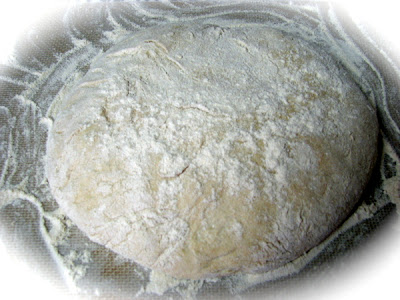
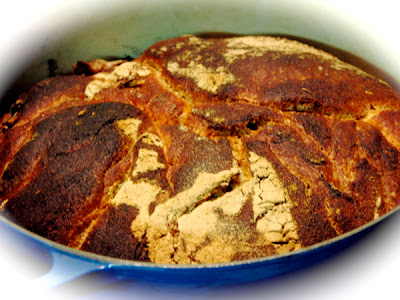
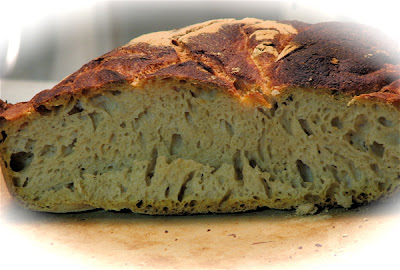
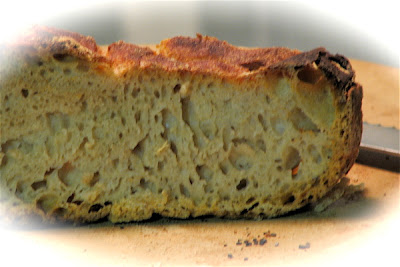
I followed the NYT's no-knead bread recipe with the following deviations and imperfections:
1.5 cup of water instead of 1 5/8 cup (tip from Rose): good, so the dough is not too wet to handle.
12-18 but preferably 18 hours rising time (see here). I let it sit for 15 hours: not long enough, the bread is a bit on the dense side. The dough probably didn't rise enough.
1.5 cup white all purpose flour and 1.5 cup whole wheat flour instead of 3 cups white: not bad except that the color is a bit yellowish. Another reason to give the dough more time to rise.
1.25 tsp salt as in the recipe: not enough, will try 1 Tbsp next time
I followed the recipe's baking time 30min with cover and 30 without: too long, the top crust is slightly burnt. Should cut the time without cover to half perhaps.
The video showed 500F baking temperature. I used 450F: good, otherwise the bread would be burnt even more.




I followed the NYT's no-knead bread recipe with the following deviations and imperfections:
Subscribe to:
Comments (Atom)

